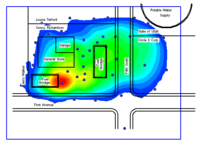GMS:2D Scatter Point Module: Difference between revisions
From XMS Wiki
Jump to navigationJump to search
No edit summary |
No edit summary |
||
| Line 7: | Line 7: | ||
[[Image:samp_2dscat.gif|center|frame|Sample Interpolation for Site Characterization]] | [[Image:samp_2dscat.gif|center|frame|Sample Interpolation for Site Characterization]] | ||
